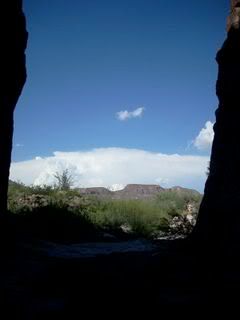@@@@@@@@@@@@@@@@
On the drive back to Redford Saturday, Enrique was in the front passenger seat, Roberto sat in the back. Roberto made some comment that he had planted a palo verde in his front yard. He found the little trees attractive.
“Oh, they’re the worst things in the desert,” Enrique said with cautioning displeasure.
“But you gotta love that green bark,” Roberto relied.
“Have you ever found yourself in a thicket of palo verde? The spines will tear you to ribbons. They don’t offer shade. The leaves are just these spindly things. The worst thing is the symbiotic relationship they have with the blister beetles. If they get on you, it’s awful.”
“Some people like them as ornamentals,” Roberto said.
“Personally, I think they’re quite beautiful,” I added. “The palo verde, that is. Don’t know what the beetles look like.”
“Sure. Some people like how the leaves curl up at night.” Enrique shook his head and continued. “But once they’ve shown you that, their repertoire is exhausted. It’s the only trick they know. And once they get a foothold, they take over. That area behind Fort Leaton is all palo verde. A whole field of spines and blisters.”
“I thought those were salt cedars,” Roberto said. “I guess you hate those too.”
“Oh, no. I’ve started the Friends of the Salt Cedar Society. We’re fighting the negative propaganda.”
“I hear they’ve developed a new herbicide for dealing with the salt cedar problem.”
“Problem! When the farmers cut down all the cottonwoods all we have are the salt cedars to keep the river from washing away the farms. It’s a wonderful shade tree. You can barbecue with the wood. You can’t do that with palo verde. Your steak will taste like tar … and blister beetles. The panaderia in Ojinaga makes a magnificent bolillo. They fire the ovens with a combination of mesquite, cottonwood, and salt cedar.”
“Salt cedar is an alien species, I understand,” Roberto said.
“Yes. The tamarisk. They were brought to this country as an ornamental. Historically, they grow along the Nile in Egypt. For over a hundred thousand years the people there learned to live with the salt cedar. If they can do it, so can we. And all these people who want to kill them off, they don’t understand that they need to plant four cottonwood saplings for every salt cedar they eradicate, or else the banks will wash away.”
“I had a salt cedar on my land,” Roberto said softly. “I tried to cut it down, but it kept growing back.” He looked out the window as we passed the rolling hills around Ozona. “I got some of that new herbicide from a fellow in Marathon. They were still testing it.”
“How did it work,” I asked.
“Like a charm,” said Roberto.
“Oh, no,” Enrique gasped in that strange way he has where you don’t know if he’s genuinely distressed. “I need to recruit more members into the Friends of the Salt Cedar Society.”
“Sounds like a loosing battle,” I said. “You need a proactive stab into the very heart of the opposition. I suggest you rent a crop dusting plane, cram it full of salt cedar seeds, and fly up and down the river.”
“Like Johnny Appleseed,” Roberto mused. “An elegant plan.”
“I’d love to type up a press release for that,” I said. “And see how many freaked-out salt cedar hating locals show up with shotguns at the airport.”
Maybe Enrique’s right. We came to accept the tumbleweed (AKA Russian thistle) a long time ago. In fact, it would be hard to envision a western movie without a few blowing across the boardwalk in a rustic town.
The conversation drifted to other invasive alien species roaming around the La Junta region. Russian boar escaped from a ranch up near Casa Piedra some years back. They’ve thrived and worked their way down the Alamito Creek until they finally reached the Rio Grande and the lush farms of the Redford Valley. And Aoudad, more commonly known as Barbary Sheep, are frisking about in the Big Bend Ranch State State Park. They too are making their way into the Redford Valley.
On a positive note, these are tasty critters and you don’t need a license to take them down. According to Enrique, the locals are taking advantage of these new-comers to these parts. I can only hope that they are roasted over glowing tamarisk coals.
@@@@@@@@@@@@@@@@@@@
When we dropped off Roberto at his little ranch on the outskirts of Presidio, Enrique phoned Ruby to see if we needed to pick anything up at the grocery store in town. He discovered that one of their dogs was in the midst of having puppies.
We hung out for an hour or so talking to Roberto. Perhaps Enrique didn’t want to deal with birthing no puppies.
And so we stood in the shade of the ramada where Roberto parks his pickup truck and leaned against the rails of his truck, facing inward to the bed … as men with trucks tend to do.
“There’s talk of putting a wall in Presidio,” Enrique said. He pointed to the river, about a hundred yards from us across a field.
Roberto told us that his wife (who was visiting friends up in Fort Davis) liked to take her morning walk along the levee. Recently she was told by two Border Patrol officers in one of their iconic green and white SUVs that she wasn’t allowed to walk there.
“They can’t do that,” I said. “Can they?”
Roberto shrugged. “We’re looking into it.”
“What’s their reason?” I asked.
“They’re looking for foot prints in the sand. People crossing the river. She was messing up the dirt path.”
Now I understood. When I was driving the other day near Langtry, I saw down a side road a Border Patrol vehicle pulling three tires behind it on chains. They were dragging the dirt road smooth so new foot prints would be noticeable. At the time I had no idea why. The only time I’d seen anything like that was years ago when I lived in Fort Worth. I saw a guy walking his pitbull near a trailer park. The dog was dragging a tire, clearly to bulk up the dog for fighting purposes.
We looked off toward the river. A couple of jack rabbits raced across the barren field and vanished into a stand of catclaw.
“Your wife needs a pitbull with a tire,” I offered. “Enrique could even sell his puppies — each one comes with a tire and a chain. The dogs follow behind you dragging the tires. I mean, it’s a win-win situation. Because it sounds to me that the Border Patrol wants your wife to do their work for them. And using my newly patented Dog-N-Drag they’d have nothing but unblemished dirt roads, smooth as the surface of the Rio Grande.”
Roberto and Enrique smiled indulgently. But I knew their feelings toward the Border Patrol (and all the other groups of uniformed and armed men on the border) ran deep and dark.
The border is an occupied territory. It will get worse before it gets better. The people there know this. But, like a unified Europe, this fucking border will fall. Unfortunately, not soon enough. And every wall, guard tower, electronic sensing device buried in the sand, and those god damn tethered blimps … all this will come down like the iron curtain. Every penny paid out to create the repressive environment is money wasted. Worse, it’s setting us up for greater future waste when these walls will have to be dismantled — when our country begins to move away from this current experiment in fascism.
@@@@@@@@@@@@@
Ruby met us with word of six puppies. By the end of the night there were eight.
We had a wonderful meal of chicken mole. And just as it was when I lived in Redford and would come by twice a week or more for dinner and late night talks, I didn’t get to bed until 2:30 in the morning.
I think it was Alan Govenar who pointed out that after the shooting of Esequiel, Enrique became a driven man. He now concentrates much of his intellectual energy on seeking justice — and not just posthumously for Esequiel, but for all of the people on the border dealing with life under occupation of the War on Drugs, which has morphed into the War on Terror.
He’s become strident. Not so playful. It’s less likely we will follow a conversation down the road of German Romantic poetry, abstract expressionism, the cosmic background radiation, the recipe for the perfect pumpkin empanada, or Julian Jaynes’ bicameral mind hypothesis. Now the conversations tend to come back to the day four American Marines in Ghillie suits stalked and killed a teenaged boy who, in the words of Enrique, was “the most innocent person on the border.” And this shooting happened a quarter mile from where Enrique lives. How would this have effected you?
@@@@@@@@@@@@@@@
Sunday I wanted to walk around some in the desert. It was about one in the afternoon. I put on some sun-block and told Enrique and Ruby I was heading out for a couple of hours. I wanted to, perhaps, hike some in Closed Canyon.
Enrique insisted that he and Ruby come along. That was fine with me, but it was incredibly hot. Probably a hundred degrees. And I’m fine with that. When I lived in Redford I would usually head out for a hike or a bike ride in the hottest time of day. With enough sunscreen and water, I’d be fine.
But, if they wanted to come along ….
We went up to the Big Hill. This is a stretch of the River Road that takes a steep climb up to a wonderful observation point which looks down onto the Rio Grande, and then it slopes dramatically down and the highway continues to Lajitas.
The Big Hill used to be a solid structure, perhaps a couple of million years ago. It functioned as a sort of damn. The area up-river toward Redford was all underwater. A big lake. In geological terminology, it was called the Redford Bolson. Eventually the waters crested … and erosion turned a series of inter-connected lakes into a serious river.
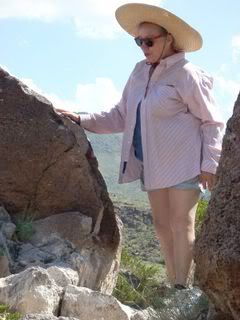
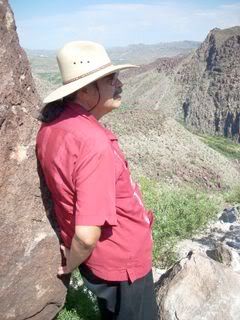
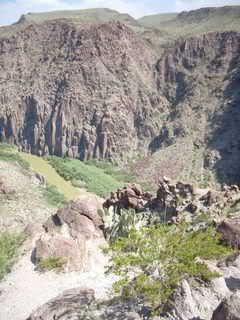
Next we headed back up-river to Closed Canyon. Enrique says that the old timers call this Tapado Canyon. Nothing strange here. Tapador is Spanish for to cap or to plug. It means the same as a closed or a box canyon. But there is a highway sign for something called Tapado Canyon a couple of miles away. There are all sorts of misnamed places and structures in the Big Bend. Official US maps say one thing, the local people say something else.
Personally I call this Lost Tourist Canyon. It starts out simple. The walls rise up steep and high. The canyon cuts through this mesa and eventually it makes it to the Rio Grande. It’s a dry canyon (most of the time), and as you head in further, you begin to find where the floor drops down. Sometimes one foot. Sometimes ten feet. The places where it drops are smooth from water erosion and thus hard to climb back up. I contend that there is a point where the adventurous tourist has screwed him or herself and can’t get back out. Like a roach motel.
Enrique decided to wait for us in the parking area. There was a picnic table under a primitive ramada. And so me and Ruby hiked out to the entrance to the canyon.
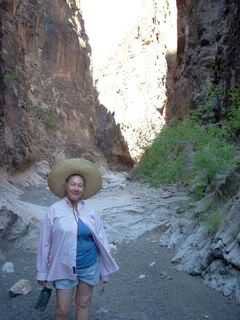
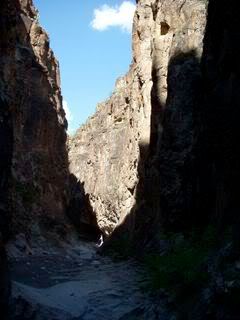
We walked in maybe a quarter mile. When we came to a drop off of maybe five feet, we decided we weren’t feeling that adventurous.
It’s a beautiful place. And I was happy to hear that Tommy Lee Jones used the canyon in his movie, “The Three Burials of Melquiades Estrada.”
My photos don’t do the place justice.
@@@@@@@@@@@
With great sadness, I climbed into my rental car early Monday morning and headed out of town.
I need to discover a way to live in Redford and yet somehow manage some sort of income — particularly one that allows me to travel.
If I find the secret, I’ll let you know.
